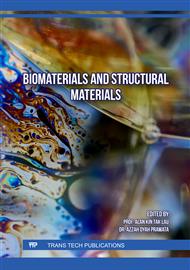[1]
M. Moliner, Y. Román-Leshkov, and M. E. Davis, Tin-containing zeolites are highly active catalysts for the isomerization of glucose in water, Proc. Natl. Acad. Sci. U. S. A., vol. 107, no. 14 (2010) 6164–6168
DOI: 10.1073/pnas.1002358107
Google Scholar
[2]
S. Yu, E. Kim, S. Park, I. K. Song, and J. C. Jung, Isomerization of glucose into fructose over Mg-Al hydrotalcite catalysts, Catal. Commun., vol. 29, (2012) 63–67
DOI: 10.1016/j.catcom.2012.09.015
Google Scholar
[3]
A. R. Permanasari, A. Fauzan, N. L. Rachmalia, R. Elfanti, and W. Wibisono, Fructose syrup production from Onggok with isomerization process by Mg/Al hydrotalcite catalyst and glucose isomerase enzyme, J. Phys. Conf. Ser., vol. 1450, no. 1 (2020)
DOI: 10.1088/1742-6596/1450/1/012002
Google Scholar
[4]
S. Xu, L. Zhang, K. Xiao, and H. Xia, Isomerization of glucose into fructose by environmentally friendly Fe/β zeolite catalysts, Carbohydr. Res., vol. 446–447 (2017) 48–51.
DOI: 10.1016/j.carres.2017.05.006
Google Scholar
[5]
Nataša Novak Tušar, Vencˇeslav Kaucˇicˇ, and Nataša Zabukovec Logar National, Functionalized Porous Silicates as Catalysts for Water and Air Purification, Hybrid Materials, Composite, and Organocatalyst. (2013) 365–383
DOI: 10.1016/b978-0-444-53876-5.00017-9
Google Scholar
[6]
S. Eskandari, A. Dong, L.T. De Castro, F. B. AB Rahman, Jeremiah Lipp, Douglas A. Blom, John R. Regalbuto, "Pushing the limits of electrostatic adsorption: charge enhanced dry impregnation of SBA-15," Catal. Today, vol. 338. June (2019) 60–71
DOI: 10.1016/j.cattod.2019.06.082
Google Scholar
[7]
M. Faisal, Surhartana, and Pardoyo, Zeolit Alam Termodifikasi Logam Fe sebagai Adsorben Fosfat ( PO43- ) pada Air Limbah, J. Kim. Sains dan Apl., vol. 18, no. 3 (2015) 91–95 (in Bahasa)
DOI: 10.14710/jksa.18.3.91-95
Google Scholar
[8]
S. Norvia, Suhartana, and Pardoyo, Dealuminasi Zeolit Alam Menggunakan Asam (HCl dan H2SO4), J. Kim. Sains dan Apl., vol. 19, no. 2 (2016) 72–76 (in Bahasa)
DOI: 10.14710/jksa.19.2.72-76
Google Scholar
[9]
B. Ramadhita and Muhdarina, Analisis Gugus Fungsi dan Keasaman Zeolit Hasil Sintesis dari Lempung Alam," Repository University of Riau. (2020) (in Bahasa)
Google Scholar
[10]
G. Fleury and M. B. J. Roeffaers, Resolving the Acid Site Distribution in Zn-Exchanged ZSM-5 with Stimulated Raman Scattering Microscopy, Catalysts, vol. 10, no. 11, 1331 (2020).
DOI: 10.3390/catal10111331
Google Scholar
[11]
N.S. Gould, B. Xu, Quantification of Acid Site Densities on Zeolites in the Presence of Solvents via Determination of Extinction Coefficients of Adsorbed Pyridine http://www.elsevier.com/open-access/userlicense/1.0/, (2017) 1–27.
DOI: 10.1016/j.jcat.2017.11.016
Google Scholar
[12]
I. Farida and D. Krisdiyanto, Modifikasi Zeolit Alam Dengan Zirconium Oxydechloride Produk PSTA-BATAN Dan Uji Katalitiknya Untuk Sintesis Senyawa Turunan Gliserol, Indones. J. Mater. Chem. IJMC, vol. 2, no. 2, (2019) 50–55. (in Bahasa)
Google Scholar
[13]
L.E. Smart and E.A. Moore, Third Edition Solid State Chemistry An Introduction, Taylor & Francis Group. Boca raton, London, New York, Singapure. (2005)
Google Scholar
[14]
V. Putranto and E. K. Jumaeri, Pemanfaatan Zeolit Dari Abu Sekam Padi Dengan Aktivasi Asam Untuk Penurunan Kesadahan Air, J. MIPA, vol. 38, no. 2 (2015) 150–159 (in Bahasa).
Google Scholar
[15]
A. Erlynata, S. Amalia, T. K. Adi, and S. N. Khalifah, Pemanfaatan Zeolit Alam, H-Zeolit Alam Dan Ti-H-Zeolit Alam Malang Sebagai Katalis Reaksi Isomerisasi Glukosa, Alchemy, vol. 3, no. 1 (2014) (in Bahasa)
DOI: 10.18860/al.v0i0.2898
Google Scholar
[16]
A. R. Pemanasari, R. P. Sihombing, C. Y. Hidayatulloh, S. Al-Ayubi, R. M. Fahmi, M. F. W. Kautsar, W. Wibisono, The effect of precipitation pH and temperature of The Mg/Al Hydrotalcite synthesis on the glucose isomerization, International Journal of Applied Science and Technology, Politekik Negeri Bandung, vol. 3, no. 1 (2022) 22–35
DOI: 10.35313/ijatr.v3i1.55
Google Scholar
[17]
Li, C., Wang, Y., Zhang, Y., Wang, M., Sun, X., & Cui, H., Isomerization Kinetics of Glucose to Fructose in Aqueous Solution with Magnesium-Aluminium Hydrotalcites, ChempubSoc, Europe, Chemistry Select, vol 5 (2020) 270-279.
DOI: 10.1002/slct.201903959
Google Scholar
[18]
Mahreni, E. Sulistiyowati, Pembuatan "High Fructose Syrup" Dari Tepung Maizena Secara Enzimatis (The Making Of High Fructose Syrup From Cornmeal Flour Through Enzymization), Prosiding SNTKP IV (2004) (in Bahasa)
Google Scholar
[19]
I. Delidovich and R. Palkovits, Catalytic activity and stability of hydrophobic Mg/Al hydrotalcite in the continuous aqueous-phase isomerization of glucose into fructose†, Catalysis Science and Technology, 4 (2014) 4322–4329
DOI: 10.1039/c4cy00776j
Google Scholar
[20]
D. Steinbach, A. Klier, A. Kruse, J. Sauer, S. Wild, and M. Zanker, Isomerization of glucose to fructose in hydrolysates from lignocellulosic biomass using hydrotalcite. Processes, Vol 8, no. 6 (2020) 1–15.
DOI: 10.3390/pr8060644
Google Scholar
[21]
Keryanti, A. R. Permanasari, R. N. Hidayah, R. Hasanah, Penentuan pH dan Suhu Optimum Isomerisasi Pembuatan Sirup Fruktosa dari Hidrolisat Onggok Menggunakan Katalis Mg/Al (Determination of Optimum Isomerization pH and Temperature of Fructose Syrup Production from Onggok Hydrolyzate using Mg/Al Catalyst), CHEESA: Chemical Engineering Research Articles, vol. 5, no.1 (2022) 1-12 (in Bahasa).
DOI: 10.25273/cheesa.v5i1.10243.1-12
Google Scholar
[22]
P. S.Kumar, L. Korving, K. J. Keesman, M. C.M. van Loosdrecht, G.J. Witkamp, Effect of pore size distribution and particle size of porous metal oxides on phosphate adsorption capacity and kinetics, Chemical Engineering Journal, Vol. 358 (2019) 160-169
DOI: 10.1016/j.cej.2018.09.202
Google Scholar



